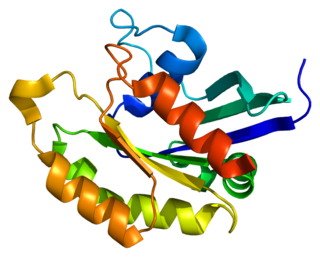
Phosphatidylinositol 3,5-bisphosphate is one of the seven phosphoinositides found in eukaryotic cell membranes. In quiescent cells, the PtdIns(3,5)P2 levels, typically quantified by HPLC, are the lowest amongst the constitutively present phosphoinositides. They are approximately 3 to 5-fold lower as compared to PtdIns3P and PtdIns5P levels, and more than 100-fold lower than the abundant PtdIns4P and PtdIns(4,5)P2. PtdIns(3,5)P2 was first reported to occur in mouse fibroblasts and budding yeast S. cerevisiae in 1997. In S. cerevisiae PtdIns(3,5)P2 levels increase dramatically during hyperosmotic shock. The response to hyperosmotic challenge is not conserved in most tested mammalian cells except for differentiated 3T3L1 adipocytes.

PIKfyve, a FYVE finger-containing phosphoinositide kinase, is an enzyme that in humans is encoded by the PIKFYVE gene.

Alpha-taxilin also known as interleukin-14 (IL-14) or high molecular weight B-cell growth factor (HMW-BCGF) is a protein that in humans is encoded by the TXLNA gene.

Ras-related protein Rab-14 is a protein that in humans is encoded by the RAB14 gene.

PAS domain-containing serine/threonine-protein kinase is an enzyme that in humans is encoded by the PASK gene.

Protein FAM107A is a protein that in humans is encoded by the FAM107A gene.

14 kDa phosphohistidine phosphatase is an enzyme that in humans is encoded by the PHPT1 gene.

Myotubularin-related protein 6 is a protein that in humans is encoded by the MTMR6 gene.

Protein phosphatase 1 regulatory subunit 11 is an enzyme that in humans is encoded by the PPP1R11 gene.

Phosphatidylinositide phosphatase SAC1 is an enzyme that in humans is encoded by the SACM1L gene.

Myotubularin-related protein 13 is a protein that in humans is encoded by the SBF2 gene.

DNA polymerase epsilon subunit 3 is an enzyme that in humans is encoded by the POLE3 gene.

Mitochondrial fission regulator 1 like is a protein that in humans is encoded by the MTFR1L gene.

SPRY domain-containing SOCS box protein 1 is a protein that in humans is encoded by the SPSB1 gene.

PH domain and leucine rich repeat protein phosphatase-like, also known as PHLPPL, is an enzyme which in humans is encoded by the PHLPPL gene.

Protein phosphatase 1 regulatory subunit 3C also known as PTG is an enzyme that in humans is encoded by the PPP1R3C gene.

Solute carrier family 25 member 39 is a protein that in humans is encoded by the SLC25A39 gene. The protein has been shown to be necessary for the import of the major antioxidant glutathione into the mitochondria.

UPF0528 protein FAM172A is a protein that in humans is encoded by the FAM172A gene.

Polyphosphoinositide phosphatase also known as phosphatidylinositol 3,5-bisphosphate 5-phosphatase or SAC domain-containing protein 3 (Sac3) is an enzyme that in humans is encoded by the FIG4 gene. Fig4 is an abbreviation for Factor-Induced Gene.

Protein VAC14 homolog, also known as ArPIKfyve, is a protein that in humans is encoded by the VAC14 gene.



















